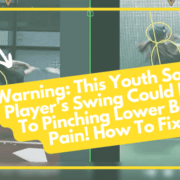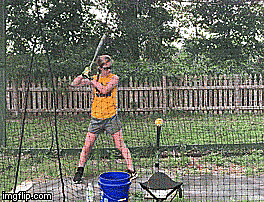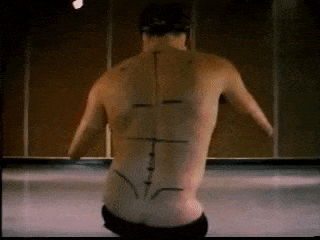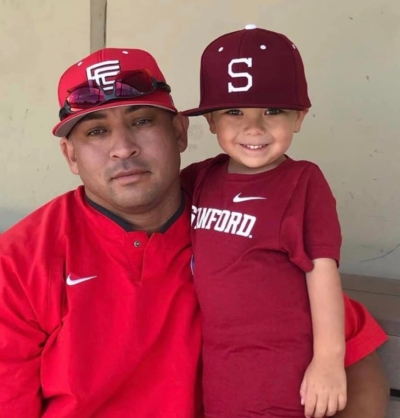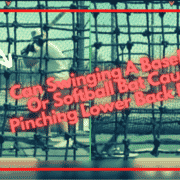In this case study, learn about a youth softball player who would have pinching lower back pain while swinging a bat, if she kept swinging like this. Discover how to fix the cause of lower back stress fractures (pars), Sciatica nerve pain, and Spondylolysis.
Get Rid Of “C-Shape Impact” Once And For All

Look at the difference in Lauryn’s body shape BEFORE, image on the left hand side (C-Shape Impact), and AFTER, image on the right hand side, using the Hunched Posture 24-hours later. Photo courtesy of Brian (dad).
With consent of Dad (Brian – Thank you), I wanted to share Feedback Session #4 (of 12) of Lauryn, who’s 11 years old…oh yeah, her consent was given too (Thanks LB!) 😀
She’s been a part of my online lesson program The Feedback Lab, since October 17th, 2016. It’s also interesting to note, her current Ball Exit Speed personal record is 66-mph at 11yo!
First, I want to say how much of a hard worker she is, and has been consistently progressing with each Feedback Session. I also want to say how supportive dad (and mom) are in all this process, and I can clearly tell dad is instilling a “Growth Mindset” in Lauryn, which is what Dr. Carol Dweck discusses in her bestselling book Mindset – a highly recommended read by the way.
A supportive parenting environment, and a Growth Mindset make my job easy and most importantly, rewarding. I say this because some may think these changes are ALL me, but I’m only shining a light down a dark path, it’s the player and parents who have to follow through, and God knows this process IS NOT easy.
The below video was the frustrating session #4 for Lauryn, which goes into:
- The ‘Pat’ – “pat on the back”, or what Lauryn progressed on mechanically, and
- The ‘Pop’ – “pop in the mouth”, or what Lauryn will be working on in the coming weeks.
SCIENCE-BASED TRAINING:
Improve your hitting strategy dramatically by applying human movement principles.
Learn not only how and what to train but also the science behind the methods.
PLEASE NOTE: to those fast-pitch softball coaches who take offense to me using Josh Donaldson as a swing example for Lauryn, I used Sierra Romero in the past few sessions – so get off my back! 😛 lol
In following, I only wanted to highlight one specific part of Lauryn’s hitting homework, the Reverse C-Shape at impact, her body illustrates in the image above. For lefties the C-Shape Impact looks like a normal ‘C’. This was a concern for dad before I did the above this Feedback Session #4.
CLICK HERE for a post I did on the Snapping Towel Drill, where I posted an image of one of my 13yo baseball hitters in this same position with a little more explanation of what the C-Shape is. In the main video above and in this post, I wanted to offer up another more effective fix than the Snapping Towel Drill…
The Hunched Posture, if you look at the above image of Lauryn on the left, her abdominals are stretching, which indicates the low back could possibly be in hyper-extension…not good. This is not adhering to the One-Joint Rule discussed in this post.
The two problems with C-Shape Impact are:
- Bleeding force at impact, and
- UNSAFE for low back.
The answer can be found in what Gymnastics refer to as the Hollow Hold Position:
Here was the corrective programming homework I gave Lauryn:
- Week 1: 1 set X 20-30 secs hold,
- Week two: 1 set X 30-40 secs hold,
- Week three: 2 sets X 30 secs hold, and
- Week four: 2 sets X 45 secs hold
…Do every other day.
The keys with this move is constantly applying pressure into the ground with the low back, and rounding the shoulders forward to create a ‘spoon’ or ‘hollow’ position with the chest.
This helps with pelvic control (rotating the pelvis to posterior), stabilizes the low back, and is KILLER for the abs – in a good way.
Look at the following three hitters and tell me what shape their spine starts in…
Ted Williams (Watch 0:21 mark):
Pete Rose Getting a Hit off Dwight Gooden:
Sadaharu Oh (868 Career Dingers in Japanese Baseball Leagues):
The Hollow Pinch Drill
The drill steps go like this…
- Hitter pinches their belly button to their belt buckle,
- Hold from stance to start of swing, and even into follow through.
Once they get it, they won’t let go of it. My hitters report back their feelings that the Hollow Pinch:
- “Just feels better”,
- “Helps show numbers and downhill shoulder angle”, and most importantly,
- “My back feels nothing while swinging” (a good thing! lol).
And like in Lauryn’s case, we see a much more effective impact position less than 24-hours later. Go easy on those pitchers out there Lauryn 😛 lol

